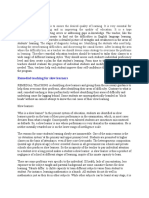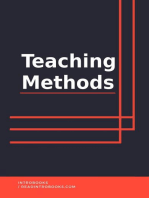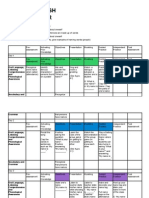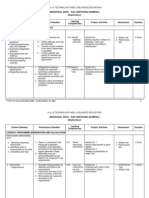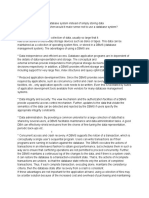Modifications and Accommodations Policy
Modifications and Accommodations Policy
Uploaded by
Francis A. BuenaventuraCopyright:
Available Formats
Modifications and Accommodations Policy
Modifications and Accommodations Policy
Uploaded by
Francis A. BuenaventuraCopyright
Available Formats
Share this document
Did you find this document useful?
Is this content inappropriate?
Copyright:
Available Formats
Modifications and Accommodations Policy
Modifications and Accommodations Policy
Uploaded by
Francis A. BuenaventuraCopyright:
Available Formats
Modifications vs.
Accommodations Policy
Definition of Terms:
Modifications are changes in what a student is expected to learn. Modifications are made when the regular curricular expectations are beyond the students level of ability. With modifications, the student is expected to learn something different from the general education standards. Changes are made to the curriculum to provide opportunities for students to participate meaningfully and productively along with other students in the classroom. Modifications include changes in the following: instructional level content performance criteria Note: modifications are rarely used, and only when students, whose disabilities are significant, are unable to meet the expectations of the regular curriculum. modification eligibility is an ILP team based decision led by a case manager. Accommodations are changes in how a student accesses information and demonstrates learning. Accommodations do not change, alter, or lower the expectations of the curriculum and does not alter what the test or assignment measures. The changes are made in order to provide a student with equal access to learning and equal opportunities to demonstrate that learning. It is simply a different approach to achieving the same curricular goals. Accommodations can include changes in the following: presentation and/or response format and procedures instructional strategies time/scheduling environment equipment Note: Accommodations are common strategies that optimize learning for all students.
Basic Definition Curriculum
Modifications Different curricular or learning goals/expectations
Changes made to curriculum to meet the needs of student Type of Student Only those with significant disabilities
Determination of Services Documentation of Services
At ILP meeting
ILP Letter home outlining how changes of curriculum affect students future academics by LS Department Progress/Grade Reports by case manager Transcripts
Accommodations Different methods to reach curricular expectations that capitalize on strengths of student No changes made to the curriculum: learning outcomes remain the same All, particularly those that are: diagnosed with mild/moderate disabilities ELD struggling At ILP meeting Through collaboration with ELD staff At teachers discretion documentation not required for informal accommodations Documented in comment section of Progress/Grade Reports by teacher (please see Progress Reports and Report Cardssection)
Examples of Modifications and Accomodations
Below are types of modifications and accommodations and possible examples. This is not a complete list: Modifications Partial completion of requirements: learning 10 words instead of 20 learning knowledge-based, concrete facts instead of abstract cause-effect relationships of various battles Adjustment made for learning rate: reinforcement of basic operations while rest of class begins fractions providing altered reading level text when reading ability/comprehension is being assessed as a standard or benchmark within a unit; typically in English or modern language classes. Alternate Curriculum Goals: for social inclusion, a students grade is weighted to reflect ability to work with others and maintain appropriate behavior rather than information Alternate Assessments: assessment task reflects changed curricular expectations and is graded according to individual achievement of the modified standard Accommodations Presenation: material of the same unit content at a lower reading level layout of worksheets, tests, etc is clear and uncluttered directions are repeated or presented in small steps graphic organizers are utilized as note-taking aids use of taped books instead of print copy key vocabulary terms are highlighted variety of visuals for new vocabulary or concepts used Responses: alternate versions of tests created to accommodate the students learning disability or language level answers marked in book rather than transferring responses to separate paper oral or non-verbal answers such as pointing to the correct answer in place of written work short answer questions replace essay prompts, with the exception of when essay writing is being assessed Setting: use of study carrel offer a quiet environment furnish special lighting provide background music make a separate room available Timing/Schedules extended time frequent breaks scheduling specific classes/activities for certain times of the day
Conclusion
It is the responsibility of every teacher to maintain the highest expectations of learning in the classroom to ensure that every student is included, challenged and successful. To this end, differentiation strategies, accommodations, and modifications offer all students equal access to the curriculum. Delivery of accommodations and modifications and additional support for students can be facilitated by contacting members of Special Education, Learning Support and the ELD departments.
You might also like
- Basketball Skills & Drills (PDFDrive) PDFDocument272 pagesBasketball Skills & Drills (PDFDrive) PDFFrancis A. Buenaventura100% (1)
- NCFP Membership FormDocument2 pagesNCFP Membership FormFrancis A. Buenaventura100% (6)
- Chess Coaching ManualDocument94 pagesChess Coaching ManualFrancis A. Buenaventura100% (9)
- ELD Observation ChecklistDocument4 pagesELD Observation ChecklistAbdus Salam QureshiNo ratings yet
- Modifications and Accommodations by Jacki OxleyDocument64 pagesModifications and Accommodations by Jacki OxleyCharline A. Radislao100% (1)
- Staff Guide To Accommodations and ModificationsDocument44 pagesStaff Guide To Accommodations and Modificationsashok kumarNo ratings yet
- Sped 334Document3 pagesSped 334api-285620168100% (3)
- Accommodations and Modifications GuideDocument44 pagesAccommodations and Modifications Guideanthonius19100% (1)
- Weaknesses in Writing A Lesson PlanDocument2 pagesWeaknesses in Writing A Lesson PlanJOHN CARMELO SAULON100% (2)
- Sports Fitness Sports and Recreation Leadership CGDocument4 pagesSports Fitness Sports and Recreation Leadership CGFrancis A. Buenaventura100% (1)
- Eraserheads' Ezine Pillbox 3Document88 pagesEraserheads' Ezine Pillbox 3Francis A. Buenaventura100% (1)
- HEALTH - K To 12 Curriculum GuideDocument51 pagesHEALTH - K To 12 Curriculum GuideFrancis A. Buenaventura100% (10)
- The Way To BeDocument168 pagesThe Way To BeMisterSarmoung100% (7)
- Building ListDocument13 pagesBuilding Listiese027No ratings yet
- Accommodations and Modifications: Making Classroom Instruction Work For All StudentsDocument23 pagesAccommodations and Modifications: Making Classroom Instruction Work For All StudentsAnonymous nbEXXvNo ratings yet
- Accommodations and Modifications Vs Interventions: AccommodationDocument1 pageAccommodations and Modifications Vs Interventions: Accommodationapi-359620014No ratings yet
- Instructional Decision MakingDocument4 pagesInstructional Decision MakingDarwiza Figueroa GuimocNo ratings yet
- AdaptationsDocument2 pagesAdaptations杨晓薇No ratings yet
- Adopting, Adapting and Modifying ELT MaterialsDocument10 pagesAdopting, Adapting and Modifying ELT MaterialsoybekNo ratings yet
- Adaptations and Modifications Reference Sheet - StaffDocument2 pagesAdaptations and Modifications Reference Sheet - Staffapi-230724261No ratings yet
- Classroom Modifications and Accommodations For Students With Learning DisabilitiesDocument2 pagesClassroom Modifications and Accommodations For Students With Learning Disabilitiesapi-281015940No ratings yet
- LA Question Paper AnswerDocument8 pagesLA Question Paper AnswerFami AlimanNo ratings yet
- Eskdale School: Assessment PolicyDocument10 pagesEskdale School: Assessment PolicyqwerNo ratings yet
- Curriculum Modifications and AdaptationsDocument18 pagesCurriculum Modifications and AdaptationsTodd R TaylorNo ratings yet
- Substitute Teacher Job Description - Short Term Rev 8-30-2011Document2 pagesSubstitute Teacher Job Description - Short Term Rev 8-30-2011ResponsiveEdNo ratings yet
- Final Irsd El Instructional and Assessment Support Guide 1Document26 pagesFinal Irsd El Instructional and Assessment Support Guide 1api-509490521No ratings yet
- AssignmentsDocument10 pagesAssignmentssumiantony34No ratings yet
- Inclusion Statement: IB Guide To Inclusive EducationDocument8 pagesInclusion Statement: IB Guide To Inclusive Educationapi-332091268No ratings yet
- Nama: Eka Pinanda Lestari NPM: 21701073149 Types of Tests Exist and Each Has A Different Purpose and Style Diagnostic TestsDocument3 pagesNama: Eka Pinanda Lestari NPM: 21701073149 Types of Tests Exist and Each Has A Different Purpose and Style Diagnostic TestsPinanda EkaNo ratings yet
- Grading and Retention of ESL StudentsDocument8 pagesGrading and Retention of ESL Studentsespinar_yuriNo ratings yet
- Accommodations and Modifications: What Teachers Need To KnowDocument28 pagesAccommodations and Modifications: What Teachers Need To KnowAlexandra ValtzidouNo ratings yet
- The Methodology For English Language TeachingDocument40 pagesThe Methodology For English Language Teachingjdary93No ratings yet
- MascotDocument2 pagesMascotmichaelpeterson0209No ratings yet
- Resources - Understanding DifferentiationDocument3 pagesResources - Understanding Differentiationvinsensius701No ratings yet
- Types of AssessmentDocument24 pagesTypes of AssessmentAnoosh FatimaNo ratings yet
- CGOET Teacher Book Practice Tests SectionDocument30 pagesCGOET Teacher Book Practice Tests SectionCarolita Rosales100% (1)
- Adapt Lesson Delivery As Needed TeslDocument4 pagesAdapt Lesson Delivery As Needed TeslFahri HaswaniNo ratings yet
- Interventions Per SubjectDocument3 pagesInterventions Per SubjectJunafel Boiser Garcia100% (2)
- Teacher & CurriculumDocument4 pagesTeacher & CurriculumprintsbyarishaNo ratings yet
- 4 Situation AnalysisDocument13 pages4 Situation AnalysisDedi KurniaNo ratings yet
- Assessment PolicyDocument9 pagesAssessment Policyeskdale_schoolNo ratings yet
- Testing Language AbilityDocument8 pagesTesting Language AbilityALEENA ROSE VARGHESENo ratings yet
- Qualities of Effective Teachers PDFDocument10 pagesQualities of Effective Teachers PDFRosmalia KasanNo ratings yet
- Trader CDDDocument19 pagesTrader CDDapi-280281803No ratings yet
- Job Description - Del Rio - 2011Document2 pagesJob Description - Del Rio - 2011ResponsiveEdNo ratings yet
- What Can We DoDocument6 pagesWhat Can We Doapi-272088006No ratings yet
- CurriculumDocument6 pagesCurriculummarlokynNo ratings yet
- Learning Standards Learning Objectives: Curricula and SyllabiDocument3 pagesLearning Standards Learning Objectives: Curricula and SyllabiSana MsoutiNo ratings yet
- 3.1 Perrone 2003Document2 pages3.1 Perrone 2003Tania Mery QuispeNo ratings yet
- Teacher Work Sample (Advanced Programs)Document4 pagesTeacher Work Sample (Advanced Programs)Hasib AhmedNo ratings yet
- Teacher Support Supervision Policy 2012Document12 pagesTeacher Support Supervision Policy 2012api-197239344No ratings yet
- Teacher Self-Appraisal RubricsDocument7 pagesTeacher Self-Appraisal Rubricsgjohnston9077No ratings yet
- Remedial Teaching For Slow LearnersDocument5 pagesRemedial Teaching For Slow Learnersedin_brow67% (3)
- ISM Accommodations Vs ModificationsDocument5 pagesISM Accommodations Vs ModificationsFrancis A. BuenaventuraNo ratings yet
- Module 7 Assignment - Lesson Part - 2Document28 pagesModule 7 Assignment - Lesson Part - 2api-185226751No ratings yet
- Instructional Adaptations in Mainstream ClassroomDocument6 pagesInstructional Adaptations in Mainstream ClassroomMary Jane Sebial ManceraNo ratings yet
- Substitute Teacher Job Description - Long Term PHS Rev 3-01-2012Document3 pagesSubstitute Teacher Job Description - Long Term PHS Rev 3-01-2012ResponsiveEdNo ratings yet
- Chapter 1 RevisedDocument3 pagesChapter 1 RevisedJessa Mae R. FontanillaNo ratings yet
- SPED Observation FormDocument3 pagesSPED Observation FormBuddy VinoNo ratings yet
- Advantages and Disadvantages of Using Instructional Materials in Teaching EslDocument2 pagesAdvantages and Disadvantages of Using Instructional Materials in Teaching EslhanitamohdhasnanNo ratings yet
- Curriculum Adaptation and ModificationDocument27 pagesCurriculum Adaptation and ModificationAnonymous f1Dn9aNo ratings yet
- Job Description Secondry School TeacherDocument2 pagesJob Description Secondry School TeachersajjaduetNo ratings yet
- AssignmentsDocument10 pagesAssignmentslinilinip78No ratings yet
- Curriculum Adaptation 1Document62 pagesCurriculum Adaptation 1dinisharacheldinu17No ratings yet
- CoteachingDocument2 pagesCoteachingapi-265397771No ratings yet
- A Practical Roadmap to Organizing and Managing the Special Ed ClassroomFrom EverandA Practical Roadmap to Organizing and Managing the Special Ed ClassroomNo ratings yet
- Ten LSDocument12 pagesTen LSFrancis A. BuenaventuraNo ratings yet
- Basketball RulesDocument12 pagesBasketball RulesFrancis A. Buenaventura100% (1)
- Scholastic Basketball CampDocument1 pageScholastic Basketball CampFrancis A. BuenaventuraNo ratings yet
- K To 12 Basic Education Curriculum Senior High School - Sports TrackDocument5 pagesK To 12 Basic Education Curriculum Senior High School - Sports TrackFrancis A. Buenaventura100% (1)
- Northern StarDocument8 pagesNorthern StarFrancis A. BuenaventuraNo ratings yet
- WellsFargo ChessTournamentDocument1 pageWellsFargo ChessTournamentFrancis A. BuenaventuraNo ratings yet
- Basketball Rules FIBADocument372 pagesBasketball Rules FIBAFrancis A. BuenaventuraNo ratings yet
- Calps Invi LetterDocument4 pagesCalps Invi LetterFrancis A. BuenaventuraNo ratings yet
- Journey Through ChessDocument100 pagesJourney Through ChessFrancis A. Buenaventura100% (1)
- WR Chapter 1Document30 pagesWR Chapter 1Andrew GreenNo ratings yet
- Population and Development EducationDocument405 pagesPopulation and Development EducationFrancis A. BuenaventuraNo ratings yet
- Wasted by Gerry AlanguilanDocument93 pagesWasted by Gerry AlanguilanFrancis A. Buenaventura100% (1)
- FIDE Trainers' Commission FIDE World Championship Sofia 2010 Anand-Topalov Efstratios GrivasDocument64 pagesFIDE Trainers' Commission FIDE World Championship Sofia 2010 Anand-Topalov Efstratios GrivasFrancis A. BuenaventuraNo ratings yet
- Teachers Guide - KulacDocument211 pagesTeachers Guide - KulacMohd Shair Razali100% (1)
- Deped q3 Week 1-5Document20 pagesDeped q3 Week 1-5yachiru121No ratings yet
- Our Global Sponsor: Gens Una Sumus (We Are One Family)Document4 pagesOur Global Sponsor: Gens Una Sumus (We Are One Family)Francis A. BuenaventuraNo ratings yet
- 1 Deped Presentation of The English Curriculum April 24Document151 pages1 Deped Presentation of The English Curriculum April 24Francis A. BuenaventuraNo ratings yet
- Music and Art - K To 12 Curriculum GuideDocument105 pagesMusic and Art - K To 12 Curriculum GuideFrancis A. Buenaventura33% (3)
- Our Global Sponsor: Gens Una Sumus (We Are One Family)Document4 pagesOur Global Sponsor: Gens Una Sumus (We Are One Family)Francis A. BuenaventuraNo ratings yet
- Edukasyong An at Pangkabuhayan (Epp) - K To 12 CurriculumDocument46 pagesEdukasyong An at Pangkabuhayan (Epp) - K To 12 CurriculumFrancis A. Buenaventura92% (53)
- Deped K To 12 Technology and Livelihood Education - ElectronicsDocument9 pagesDeped K To 12 Technology and Livelihood Education - Electronicsyachiru121No ratings yet
- Deped K To 12 Technology and Livelihood Education - Commercial CookingDocument5 pagesDeped K To 12 Technology and Livelihood Education - Commercial Cookingyachiru121100% (7)
- Deped K To 12 Technology and Livelihood Education - Nail CareDocument6 pagesDeped K To 12 Technology and Livelihood Education - Nail Careyachiru12175% (4)
- Deped K To 12 Technology and Livelihood Education - DomracDocument6 pagesDeped K To 12 Technology and Livelihood Education - Domracyachiru121No ratings yet
- DLL - House KeepingDocument14 pagesDLL - House KeepingEverly Oballo100% (1)
- The Honorable Ones The Principle of SMA Negeri 01 TanjungDocument1 pageThe Honorable Ones The Principle of SMA Negeri 01 TanjungAnonymous rNBKwCNo ratings yet
- Programme Specification SessionDocument7 pagesProgramme Specification SessionCINDYLINo ratings yet
- Clinical Pharmacist in ICUDocument26 pagesClinical Pharmacist in ICUApriyanNo ratings yet
- X STD Important Formulas KalviamuthuDocument9 pagesX STD Important Formulas KalviamuthuDurai GopalNo ratings yet
- 2024 Gce o Level Exam Calendar (Tentative) - VFDocument1 page2024 Gce o Level Exam Calendar (Tentative) - VFjaejaekay1308No ratings yet
- Chinese Universities Agency Number and List in EaDocument17 pagesChinese Universities Agency Number and List in EarimshaafshenNo ratings yet
- Effect of Transformational Leadership On Employees' Job Satisfaction andDocument8 pagesEffect of Transformational Leadership On Employees' Job Satisfaction andAbetare DomiNo ratings yet
- "NEW" SOCIAL STUDIES HOPE TO ACHIEVE Lesson 3Document30 pages"NEW" SOCIAL STUDIES HOPE TO ACHIEVE Lesson 3Rosmie Jane CantongNo ratings yet
- CH1 Activity2 SolvedDocument6 pagesCH1 Activity2 SolvedAqib Abass100% (1)
- Tintin DLPDocument11 pagesTintin DLPAnielof TandogNo ratings yet
- PTA Meeting AtttendanceDocument6 pagesPTA Meeting AtttendanceMARIA FE SERRANONo ratings yet
- Home Visitation Accomplishment Report: Poloyagan Integrated SchoolDocument2 pagesHome Visitation Accomplishment Report: Poloyagan Integrated SchoolChristine BonillaNo ratings yet
- IoT PDFDocument10 pagesIoT PDFhunajeatmalingNo ratings yet
- Traditional Vs Modern Course DesignDocument3 pagesTraditional Vs Modern Course DesignJoanna SiglosNo ratings yet
- Thesis StatementDocument37 pagesThesis Statementtreer987No ratings yet
- Resume From ParthibanDocument2 pagesResume From ParthibanrajasekaranvgNo ratings yet
- Pecjak Kosir Personality Motivation Factors and Difficulties in Career Decision Making in Secondary School Students PDFDocument18 pagesPecjak Kosir Personality Motivation Factors and Difficulties in Career Decision Making in Secondary School Students PDFGlupača PravaNo ratings yet
- PDFDocument4 pagesPDFTiwana PushpNo ratings yet
- Impact of Domestic Violence On Children - Through Their EyesDocument38 pagesImpact of Domestic Violence On Children - Through Their EyesDanny GoldstoneNo ratings yet
- Edexel June 2016 Mark SchemeDocument13 pagesEdexel June 2016 Mark SchemeJo PatrickNo ratings yet
- Macro Perspective of Tourism and Hospitality1Document6 pagesMacro Perspective of Tourism and Hospitality1Bella Maria0% (1)
- Buku Panduan Akademik 2016-2017Document167 pagesBuku Panduan Akademik 2016-2017sunray_ninerNo ratings yet
- Language Is The Key To The World.: Victoria-Languages - deDocument36 pagesLanguage Is The Key To The World.: Victoria-Languages - deYosr JemaaNo ratings yet
- Science 2010 Pearson 459 63Document6 pagesScience 2010 Pearson 459 63Lucas DutraNo ratings yet
- Classical Organization TheoryDocument25 pagesClassical Organization Theoryદિપક પટેલNo ratings yet
- Digital Photography: Course DescriptionDocument1 pageDigital Photography: Course Descriptionfjl_302711No ratings yet
- Adult Literacy: A Handbook For Development WorkersDocument11 pagesAdult Literacy: A Handbook For Development WorkersOxfam100% (2)




















































